Curry tree - Murraya koenigii: https://en.wikipedia.org/wiki/Curry_tree
I've just got my hands on a baby curry tree (Murraya koenigii). Any hints or tips for me?
Indian curry tree is a sub tropical tree so in colder locations it would have to be protected or brought indoors when it gets too cold.
It does fine in a pot, but it likes to escape so you have to make sure you up pot before then. It is very aromatic so most pests leave it alone. It does get up to twenty feet. Mine is in the ground. I can cut it back to the ground and it will still come back so it takes to pruning just fine. The red berries that come after flowering are also edible. It does reseed in the right environment.
My temperatures are between 51-90 humidity 67-100%. The plant is in full sun.
It does fine in a pot, but it likes to escape so you have to make sure you up pot before then. It is very aromatic so most pests leave it alone. It does get up to twenty feet. Mine is in the ground. I can cut it back to the ground and it will still come back so it takes to pruning just fine. The red berries that come after flowering are also edible. It does reseed in the right environment.
My temperatures are between 51-90 humidity 67-100%. The plant is in full sun.
-
pepperhead212
- Super Green Thumb
- Posts: 2887
- Joined: Wed Oct 15, 2014 1:52 pm
- Location: Woodbury NJ Zone 7a/7b
I have a curry tree that I've had potted for 11 or 12 years now. I have to bring it in as soon as I know it will get below 50º, and similarly, I can't put it back out until I know that it won't get below 50º for a low. The plant in in the citrus family, so it can come down with similar diseases and bugs. The one insect that I have had major problems with , once I bring it indoors (outside, no problems!) is scale (which is farmed by ants), and once in a while spider mites. Last year, when I re-potted the plant, I mixed a generous amount of DE into the soil mix, esp. the upper 2" of soil mix, and had no problems with scale on these, or the kaffir limes, both of which got them the year before. Here is the one that I have, showing what looks like flower buds, but is actually the new growth. As you can see, mine is in a 4 gal bucket, that is made into a sub-irrigated planter, which the plant seems to thrive in - I had it in there from September 2017, to now.
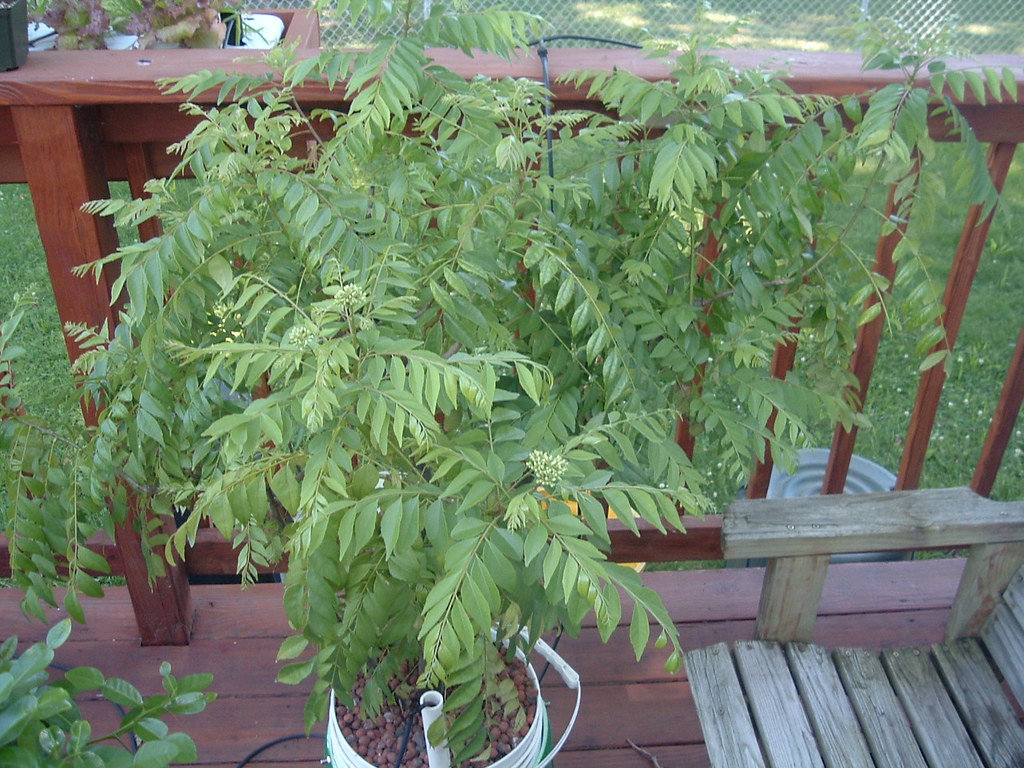 DSCF0693 by pepperhead212, on Flickr
DSCF0693 by pepperhead212, on Flickr
Here is a good YouTube video about growing curry trees. About half way through the first is where you'll be starting, since you have a plant already - the first part is about starting from seeds. The second video is about trimming and re-potting. The third is another about trimming. As you will see, you can cut these things severely, and they don't mind!
https://www.youtube.com/watch?v=na9XeH2Cicg
https://www.youtube.com/watch?v=7XfZoslbUf4
https://www.youtube.com/watch?v=x3VxuYl-wAc
They like well drained soil, and I started out with a 3 gal pot, adding some extra perlite to the soil mix, and some worm castings. Every 2-3 years it needs re-potting, and severe pruning and root pruning, and as soon as I put it back into new mix, it begins a bunch of new growth. I bring it indoors, and place it in front of a S facing window for the rest of the fall, the winter, and into the spring, until it gets warm enough to put it outside.
As those videos will show, you can trim a lot off of these, with no harm. Sometimes, when it starts getting too heavily foliated, you'll have to trim a BUNCH off of it, but that's down the road, after yours gets settled in. And you'll also get some suckers coming up out of the ground - that might be where your plant came from, or maybe grown from seeds. You can just let it keep growing, and eventually, you'll have another plant, next to the original one, though eventually, you'll have to start pulling them, or sharing them with friends.
For trimming these, when I cut the thick stalks, I seal them, with a pruning paint, "liquid electric tape", or liquid skin. When left, as is, the unsealed cut slowly turns brown, with the brown slowly moving down the stem.
 DSCF0693 by pepperhead212, on Flickr
DSCF0693 by pepperhead212, on FlickrHere is a good YouTube video about growing curry trees. About half way through the first is where you'll be starting, since you have a plant already - the first part is about starting from seeds. The second video is about trimming and re-potting. The third is another about trimming. As you will see, you can cut these things severely, and they don't mind!
https://www.youtube.com/watch?v=na9XeH2Cicg
https://www.youtube.com/watch?v=7XfZoslbUf4
https://www.youtube.com/watch?v=x3VxuYl-wAc
They like well drained soil, and I started out with a 3 gal pot, adding some extra perlite to the soil mix, and some worm castings. Every 2-3 years it needs re-potting, and severe pruning and root pruning, and as soon as I put it back into new mix, it begins a bunch of new growth. I bring it indoors, and place it in front of a S facing window for the rest of the fall, the winter, and into the spring, until it gets warm enough to put it outside.
As those videos will show, you can trim a lot off of these, with no harm. Sometimes, when it starts getting too heavily foliated, you'll have to trim a BUNCH off of it, but that's down the road, after yours gets settled in. And you'll also get some suckers coming up out of the ground - that might be where your plant came from, or maybe grown from seeds. You can just let it keep growing, and eventually, you'll have another plant, next to the original one, though eventually, you'll have to start pulling them, or sharing them with friends.
For trimming these, when I cut the thick stalks, I seal them, with a pruning paint, "liquid electric tape", or liquid skin. When left, as is, the unsealed cut slowly turns brown, with the brown slowly moving down the stem.
-
MaLiorzh
- Full Member
- Posts: 50
- Joined: Fri May 18, 2018 8:08 am
- Location: Brittany / Breizh / Bretagne 9a
Thanks to both of you (even if I do have to do a bit F to C converting  )
)
Dave can I ask you what DE is that you mentioned.
"I mixed a generous amount of DE into the soil mix"
I also grow kaffir lime leaf bushes and they suffer from scale insect. I've found that my kaffir lime leaf bushes really suffer from being brought into the house. First, they start to etiolate even though in a window. Then second, when they go back outside in late spring, the long spindly etiolated leaves/twigs burn in the sun and wind even in partial shade/shelter. You can imagine that a scale insect infestation is the last thing they need on top of the rest.
Dave can I ask you what DE is that you mentioned.
"I mixed a generous amount of DE into the soil mix"
I also grow kaffir lime leaf bushes and they suffer from scale insect. I've found that my kaffir lime leaf bushes really suffer from being brought into the house. First, they start to etiolate even though in a window. Then second, when they go back outside in late spring, the long spindly etiolated leaves/twigs burn in the sun and wind even in partial shade/shelter. You can imagine that a scale insect infestation is the last thing they need on top of the rest.
-
pepperhead212
- Super Green Thumb
- Posts: 2887
- Joined: Wed Oct 15, 2014 1:52 pm
- Location: Woodbury NJ Zone 7a/7b
MaLiorzh, The DE I referred to is diatomaceous earth. Something else I use on these plants when indoors is a cedar oil based plant spray, which helps greatly with spider mites, and another that helps, which I spray once I take them back out, is orange oil. When I had that really bad scale infestation, I mixed some pyrethrins in some, and it killed them, but I had to wipe them off the undersides of all of the leaves. Fortunately, the great majority of them can be trimmed off, but they grow back with incredible speed. Every season, I trim most of them off, before I bring them back in, and before I take them back out, and while inside, I try to keep them trimmed so that they are not very bushy, as that seems to help.
-
MaLiorzh
- Full Member
- Posts: 50
- Joined: Fri May 18, 2018 8:08 am
- Location: Brittany / Breizh / Bretagne 9a
My Curry tree is looking decidedly ill. When it arrived by post in the summer I potted it up with a special citrus soil mix I bought from a local shop that I also use for my kaffir lime trees. Through the summer I kept it well watered and the plant grew a few more leaves but never really looked in good form. I always had the impression that it was struggling a little. When the outside temperature started to drop below 10°C at night I brought it inside, next to the gotu kola, in a south facing kitchen window (as little central heating and as much sun light as I can manage). The growth stopped immediately and since then, little by little, the plant has lost all its leaves. What remains is a green stick in a pot. I find it hard to believe that it could grow back from what is left, that and what is left has to survive the next few months in the same place before it can go back outside again.
- applestar
- Mod
- Posts: 30551
- Joined: Thu May 01, 2008 7:21 pm
- Location: Zone 6, NJ (3/M)4/E ~ 10/M(11/B)
My attempted cutting propagation of curry branch didn’t make it, but it hang on for a long time.
While I was nursing it along, mine lost all its leaves during the winter indoor stay — I believe due to mite infestation, but it tried to come back in spring twice (2 years) before it finally succumbed.
Some of my other citruses also lose leaves during the winter indoor stay. Sometimes/or also due to accidental overwatering (water uptake can be variable, depending on its metabolism) and possibly due to lower indoor temperature than it can maintain the leaves, causing it to enter dormancy (most citruses prefer mid-60’s°F or higher to stay in active growth). Low humidity is another cause for stress, and that aggravates the mite infestation. Scale insect infestation is a regular problem — I believe ants bring them to pasture on my plants.
So don’t give up on it just because it lost leaves and is looking like sticks.
Currently, first citrus to start leafing out here is key lime.
While I was nursing it along, mine lost all its leaves during the winter indoor stay — I believe due to mite infestation, but it tried to come back in spring twice (2 years) before it finally succumbed.
Some of my other citruses also lose leaves during the winter indoor stay. Sometimes/or also due to accidental overwatering (water uptake can be variable, depending on its metabolism) and possibly due to lower indoor temperature than it can maintain the leaves, causing it to enter dormancy (most citruses prefer mid-60’s°F or higher to stay in active growth). Low humidity is another cause for stress, and that aggravates the mite infestation. Scale insect infestation is a regular problem — I believe ants bring them to pasture on my plants.
So don’t give up on it just because it lost leaves and is looking like sticks.
Currently, first citrus to start leafing out here is key lime.
-
pepperhead212
- Super Green Thumb
- Posts: 2887
- Joined: Wed Oct 15, 2014 1:52 pm
- Location: Woodbury NJ Zone 7a/7b
Sorry to hear about this, Apple. I hope the next attempt is better.
Something that I saw on youtube (on California gardening) was propagating the curry tree from seeds - something I have never tried, but it looks easy. Do you get seeds on yours? Mine usually starts flowering indoors, but I snip them off immediately - the smell is sickeningly sweet (which I hate in the house!), and attracts bees and countless insects in the spring. After the flowers are gone, I usually just cut the seeds, to funnel the energy to the rest of the plant.
Something that I saw on youtube (on California gardening) was propagating the curry tree from seeds - something I have never tried, but it looks easy. Do you get seeds on yours? Mine usually starts flowering indoors, but I snip them off immediately - the smell is sickeningly sweet (which I hate in the house!), and attracts bees and countless insects in the spring. After the flowers are gone, I usually just cut the seeds, to funnel the energy to the rest of the plant.
-
MaLiorzh
- Full Member
- Posts: 50
- Joined: Fri May 18, 2018 8:08 am
- Location: Brittany / Breizh / Bretagne 9a
From an exchange on a blog I've gathered that the temperature should be maintained around 21°C (70°F) or above. In order to achieve this I've created a mini cloche from an old transparent plastic water bottle with the bottom cut off. Equally, the plant's going into my bedroom where we keep the temperature a little higher - stop that sniggering please!
-
pepperhead212
- Super Green Thumb
- Posts: 2887
- Joined: Wed Oct 15, 2014 1:52 pm
- Location: Woodbury NJ Zone 7a/7b
-
pepperhead212
- Super Green Thumb
- Posts: 2887
- Joined: Wed Oct 15, 2014 1:52 pm
- Location: Woodbury NJ Zone 7a/7b
I tried air layering that curry tree, just to see if I could, and it worked! I did the kaffir lime about 10 years ago, and it took longer.
I finally cut that air layered section of the curry tree out, to see if it had rooted - it was getting very large, and I was going to trim a bunch of it off again, and take it up to that Indian grocer I give it to, since I'm going up there to a dentist appt tomorrow near there. It rooted some in about 4½ months - it took the kaffir lime 7 months, but the branch didn't get nearly as large. About the same amount of rooting though; I hope the roots support this many leaves.
Here is the Rooter Pot, first put on the branch in April:
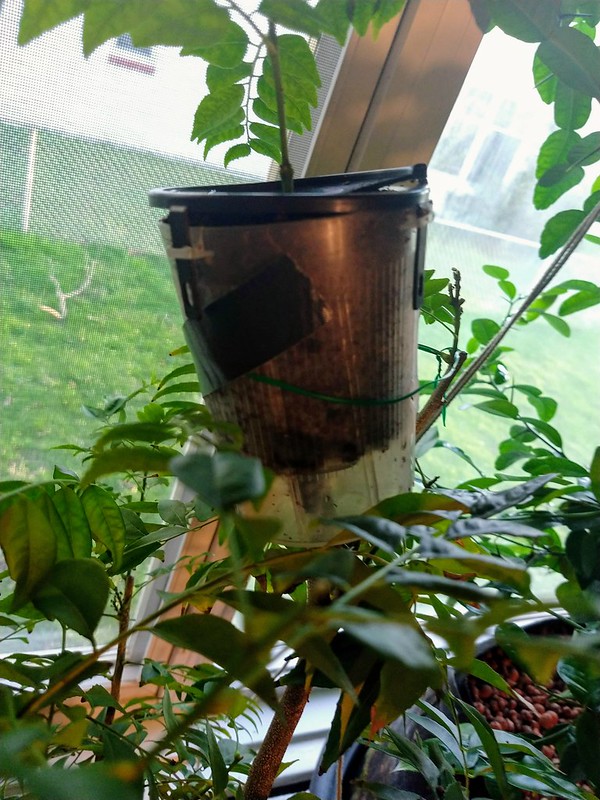 Rooting Pot set up on curry tree, 4-13-20 by pepperhead212, on Flickr
Rooting Pot set up on curry tree, 4-13-20 by pepperhead212, on Flickr
And here it is in June, with new growth on the plant, before and after the pot was covered up:
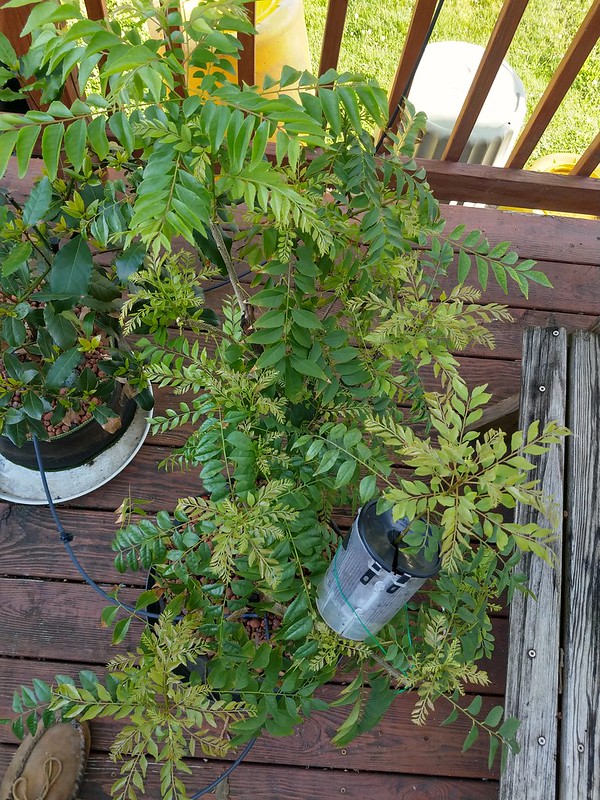 The curry tree, showing the areas of new growth, 6-8 by pepperhead212, on Flickr
The curry tree, showing the areas of new growth, 6-8 by pepperhead212, on Flickr
 Curry tree 6-27 by pepperhead212, on Flickr
Curry tree 6-27 by pepperhead212, on Flickr
 Roots forming on the air larered branch of the curry tree, started on 4-13, and uncovered on 9-2. by pepperhead212, on Flickr
Roots forming on the air larered branch of the curry tree, started on 4-13, and uncovered on 9-2. by pepperhead212, on Flickr
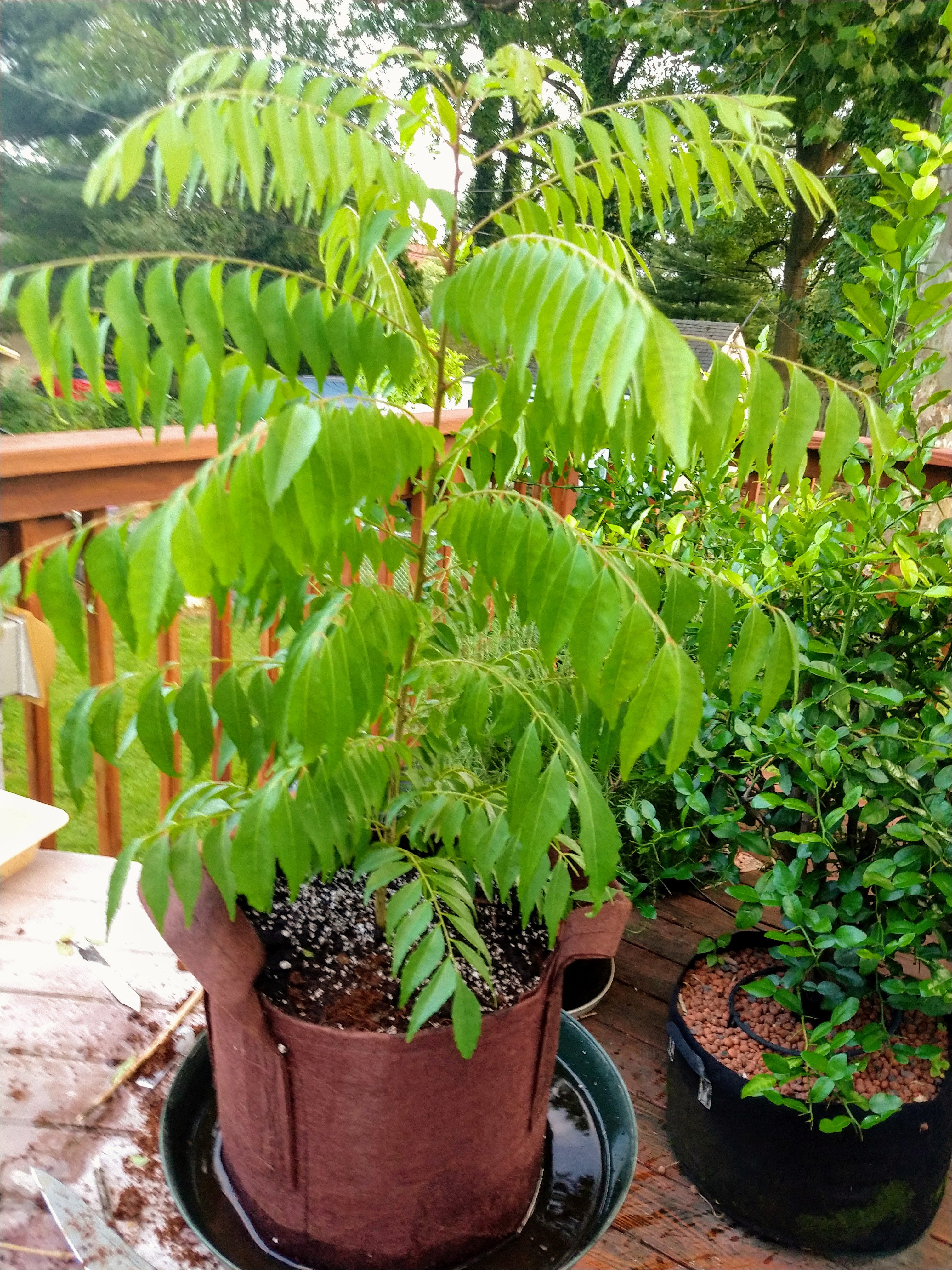 New air layered curry tree, potted in a 3 gallon fabric container, 9-2 by pepperhead212, on Flickr
New air layered curry tree, potted in a 3 gallon fabric container, 9-2 by pepperhead212, on Flickr
Here's the tree that I cut that large section out of, in the center. You can see there is still a lot left there, and I have cut generous amounts of it recently.
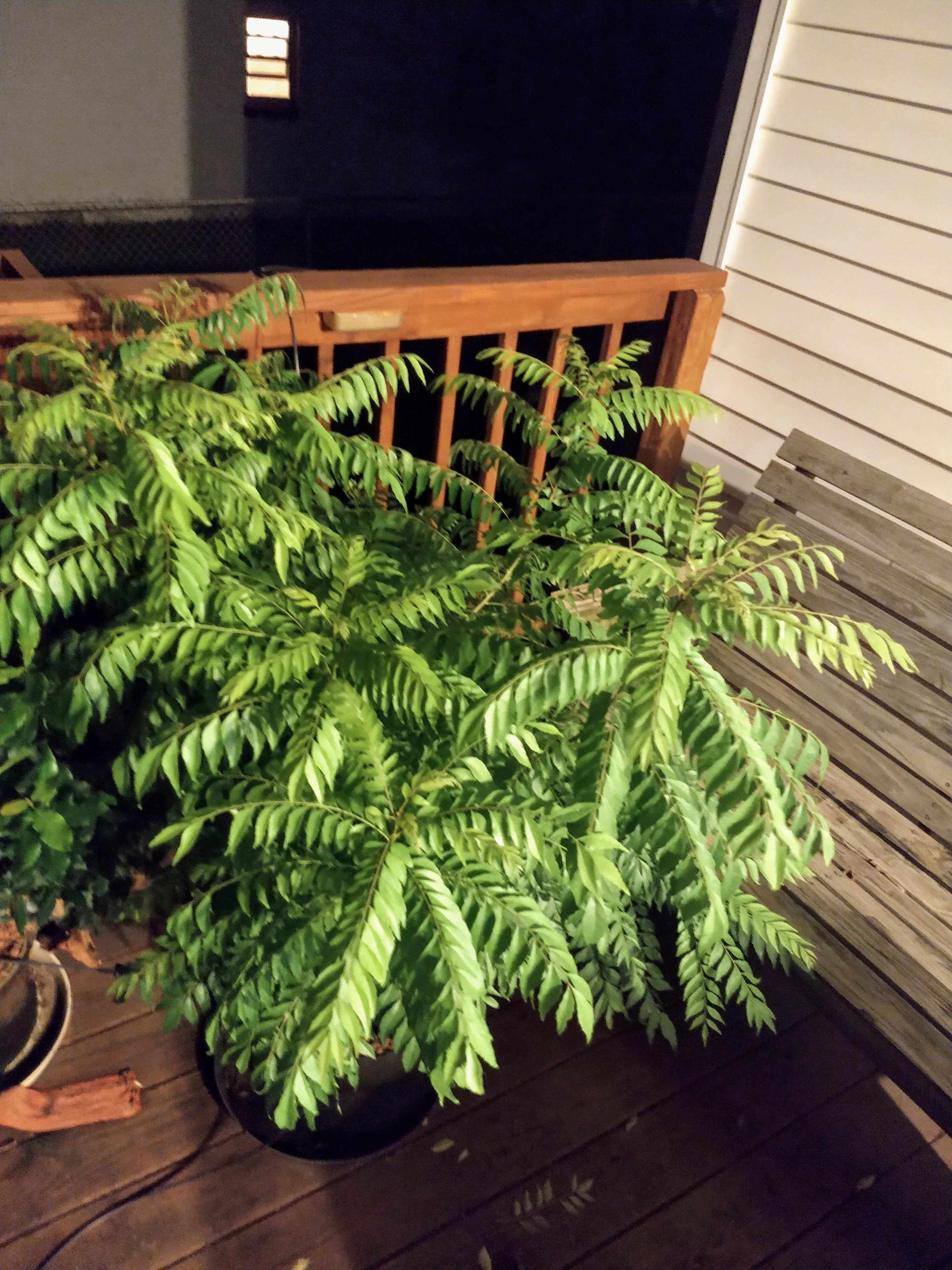 Curry tree, with the new tree cut out of the center. 9-2 by pepperhead212, on Flickr
Curry tree, with the new tree cut out of the center. 9-2 by pepperhead212, on Flickr
I finally cut that air layered section of the curry tree out, to see if it had rooted - it was getting very large, and I was going to trim a bunch of it off again, and take it up to that Indian grocer I give it to, since I'm going up there to a dentist appt tomorrow near there. It rooted some in about 4½ months - it took the kaffir lime 7 months, but the branch didn't get nearly as large. About the same amount of rooting though; I hope the roots support this many leaves.
Here is the Rooter Pot, first put on the branch in April:
 Rooting Pot set up on curry tree, 4-13-20 by pepperhead212, on Flickr
Rooting Pot set up on curry tree, 4-13-20 by pepperhead212, on FlickrAnd here it is in June, with new growth on the plant, before and after the pot was covered up:
 The curry tree, showing the areas of new growth, 6-8 by pepperhead212, on Flickr
The curry tree, showing the areas of new growth, 6-8 by pepperhead212, on Flickr Curry tree 6-27 by pepperhead212, on Flickr
Curry tree 6-27 by pepperhead212, on Flickr Roots forming on the air larered branch of the curry tree, started on 4-13, and uncovered on 9-2. by pepperhead212, on Flickr
Roots forming on the air larered branch of the curry tree, started on 4-13, and uncovered on 9-2. by pepperhead212, on Flickr New air layered curry tree, potted in a 3 gallon fabric container, 9-2 by pepperhead212, on Flickr
New air layered curry tree, potted in a 3 gallon fabric container, 9-2 by pepperhead212, on FlickrHere's the tree that I cut that large section out of, in the center. You can see there is still a lot left there, and I have cut generous amounts of it recently.
 Curry tree, with the new tree cut out of the center. 9-2 by pepperhead212, on Flickr
Curry tree, with the new tree cut out of the center. 9-2 by pepperhead212, on FlickrMurraya koenegii is what is used in India for things like traditional chicken biryani. It is the real Indian curry but it does not taste anything like what you buy in a bottle sold as curry powder. It is not usually the only flavor in Indian curries. Like garam marsala, every cook had their special blend of spices and herbs.
https://www.youtube.com/watch?v=LPEE02o ... dpaKitchen
Curry powder is a blend of spices. Anything from 8-20 different spices are combined. Usually it contains turmeric for color and cumin (for that familiar curry flavor).
I do have murraya in my yard. It will become a large bush in the ground (over 15 ft), It produces edible berries after it blooms. The seeds are toxic though and should never be eaten. I have to try to keep my plant from blooming because it does reseed and the seedlings are not that easy to pull out. My tree is not deciduous, but I don't have to worry about frost either.
If you keep it in a pot and don't cut it, it will grow straight up. Cut it so it will be bushy, especially if you plant on using the leaves.
I really don't have any pest problem related to this tree. The tree itself may become a weed though. It does well in full sun or with some light shade. It does not like to be in heavy shade and it would need to be in a fairly large pot, it does not like being confined to small pots.
It does not have a high fertilizer requirement. I actually purposely don't feed it much, because I need to keep the growth checked.
https://specialtyproduce.com/produce/Cu ... _13085.php
https://specialtyproduce.com/produce/cu ... s_1119.php
https://www.youtube.com/watch?v=LPEE02o ... dpaKitchen
Curry powder is a blend of spices. Anything from 8-20 different spices are combined. Usually it contains turmeric for color and cumin (for that familiar curry flavor).
I do have murraya in my yard. It will become a large bush in the ground (over 15 ft), It produces edible berries after it blooms. The seeds are toxic though and should never be eaten. I have to try to keep my plant from blooming because it does reseed and the seedlings are not that easy to pull out. My tree is not deciduous, but I don't have to worry about frost either.
If you keep it in a pot and don't cut it, it will grow straight up. Cut it so it will be bushy, especially if you plant on using the leaves.
I really don't have any pest problem related to this tree. The tree itself may become a weed though. It does well in full sun or with some light shade. It does not like to be in heavy shade and it would need to be in a fairly large pot, it does not like being confined to small pots.
It does not have a high fertilizer requirement. I actually purposely don't feed it much, because I need to keep the growth checked.
https://specialtyproduce.com/produce/Cu ... _13085.php
https://specialtyproduce.com/produce/cu ... s_1119.php
-
pepperhead212
- Super Green Thumb
- Posts: 2887
- Joined: Wed Oct 15, 2014 1:52 pm
- Location: Woodbury NJ Zone 7a/7b
@Gary, That curry tree is unrelated (sort of) to that spice blend we know as curry powder. In fact, that word curry is an abomination of an Indian word kari, or kadhi, which is how they refer to spiced dishes, which use many different spice mixes, depending on the. But the curry powder was supposely developed by the British, back in the centuries when they colonized India, and when they went "back home", they wanted something that could give them something similar to what they had been eating in India, because they liked it so much, but they couldn't duplicate it! The curry powders gave them a way of delivering a similar flavor, without having the 10 or 15 spices on hand. Curry leaves are used in many of those types of dishes in India, as well as SE Asia (I originally started growing it for Malaysian cooking), which is how the name developed, but it is not something found in curry powder. It is not really that good dried. Only in recent years have I seen it on a regular basis in the Indian markets, and it still doesn't look real good. One of the few herbs used in Indian cooking - holy basil, or tulsi, is another.
-
pepperhead212
- Super Green Thumb
- Posts: 2887
- Joined: Wed Oct 15, 2014 1:52 pm
- Location: Woodbury NJ Zone 7a/7b
Back in September, a few seeds finally started ripening on my curry tree - seeds that showed up on the plant way back in June! They stayed green all summer, and I finally got them totally ripening at the end of September.
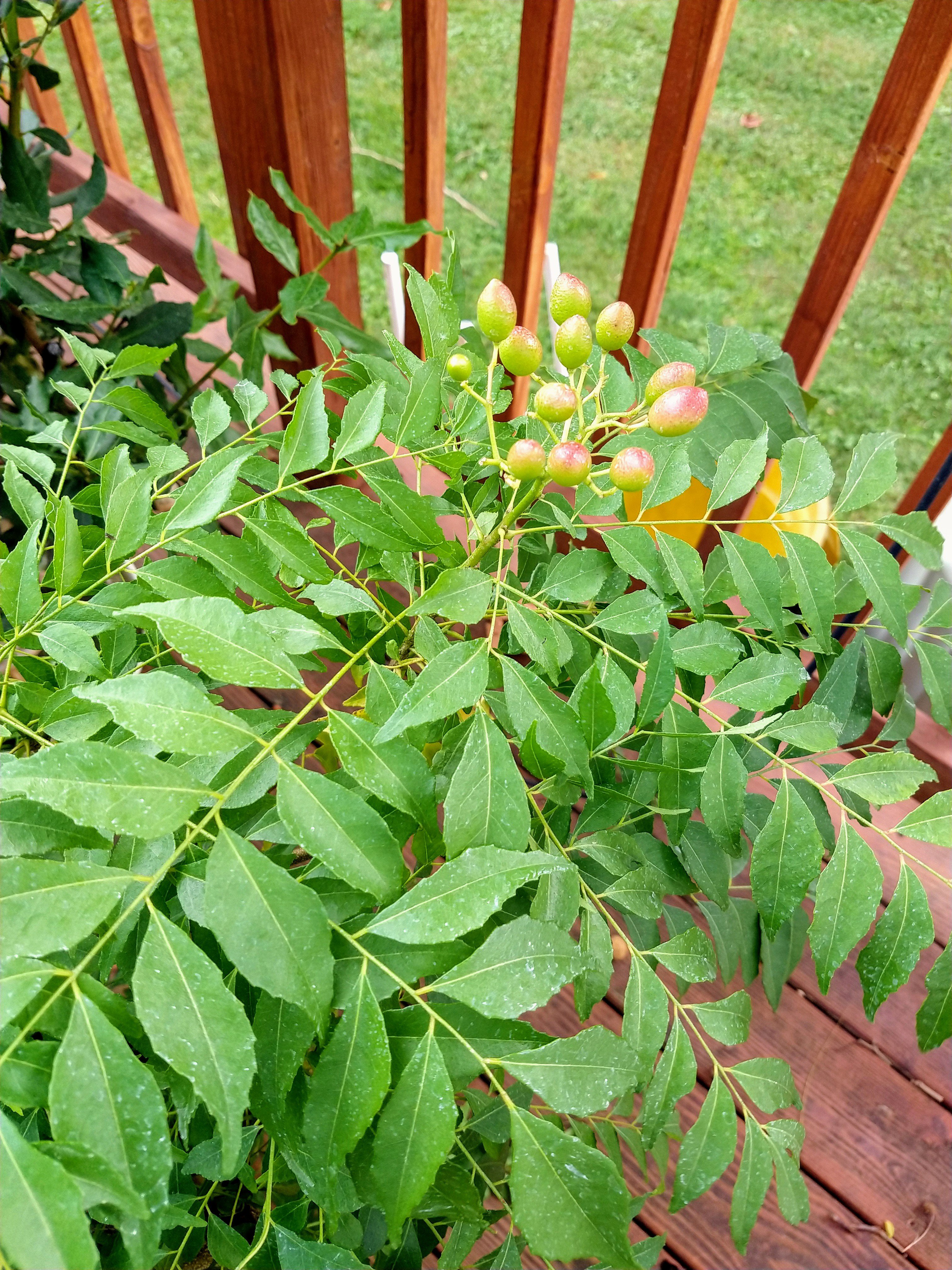 Seeds of the curry tree, from the spring, just now starting to ripen. 9-15 by pepperhead212, on Flickr
Seeds of the curry tree, from the spring, just now starting to ripen. 9-15 by pepperhead212, on Flickr
The seeds are actually the fruits of the plant, with a single seed inside, starting to root, by the time they get dark, and soft:
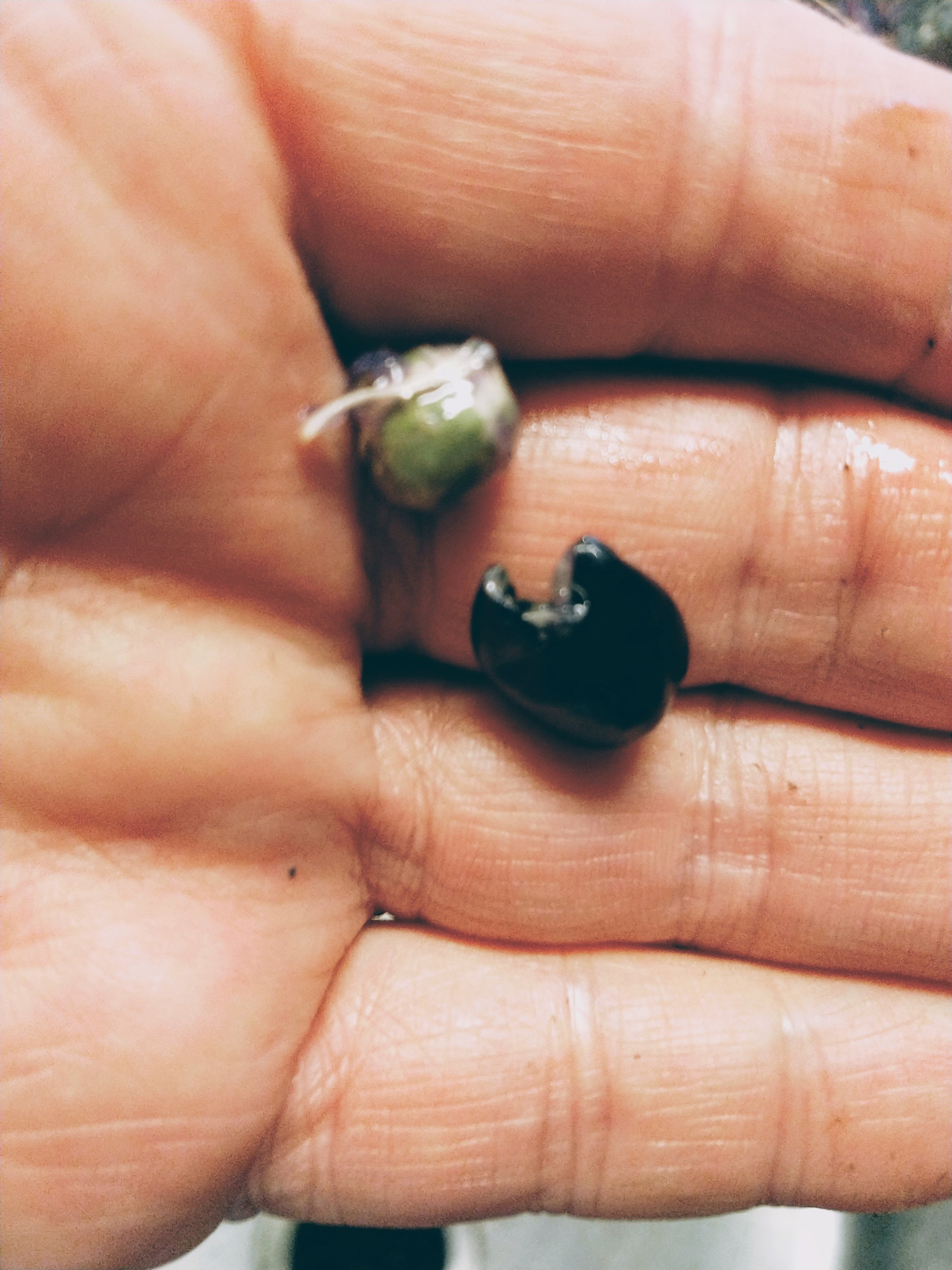 Seed, squeezed out of a curry tree fruit, showing the root already started! 9-29 by pepperhead212, on Flickr
Seed, squeezed out of a curry tree fruit, showing the root already started! 9-29 by pepperhead212, on Flickr
This one is eventually the largest of the 5 seedlings:
 Curry tree seedling, growing from a seed. 10-15 by pepperhead212, on Flickr
Curry tree seedling, growing from a seed. 10-15 by pepperhead212, on Flickr
Here are those curry tree seedlings more than 3 months after planting! I had a couple more than the original 3 germinate, and two of these were actually came up late, in the pots with 2 of the others, and I left them, since they were an inch or so apart. I had them under a blue LED light, and they seemed to grow well, though slowly (probably the norm), not getting leggy. I re-potted them today, wetting the mix with some dilute hydroponics nutrients, also adding a few drops of Bt israelensis, for the fungus gnats. I transferred them to sit under a stronger LED 5,000k bulb - I'll see if they grow faster.
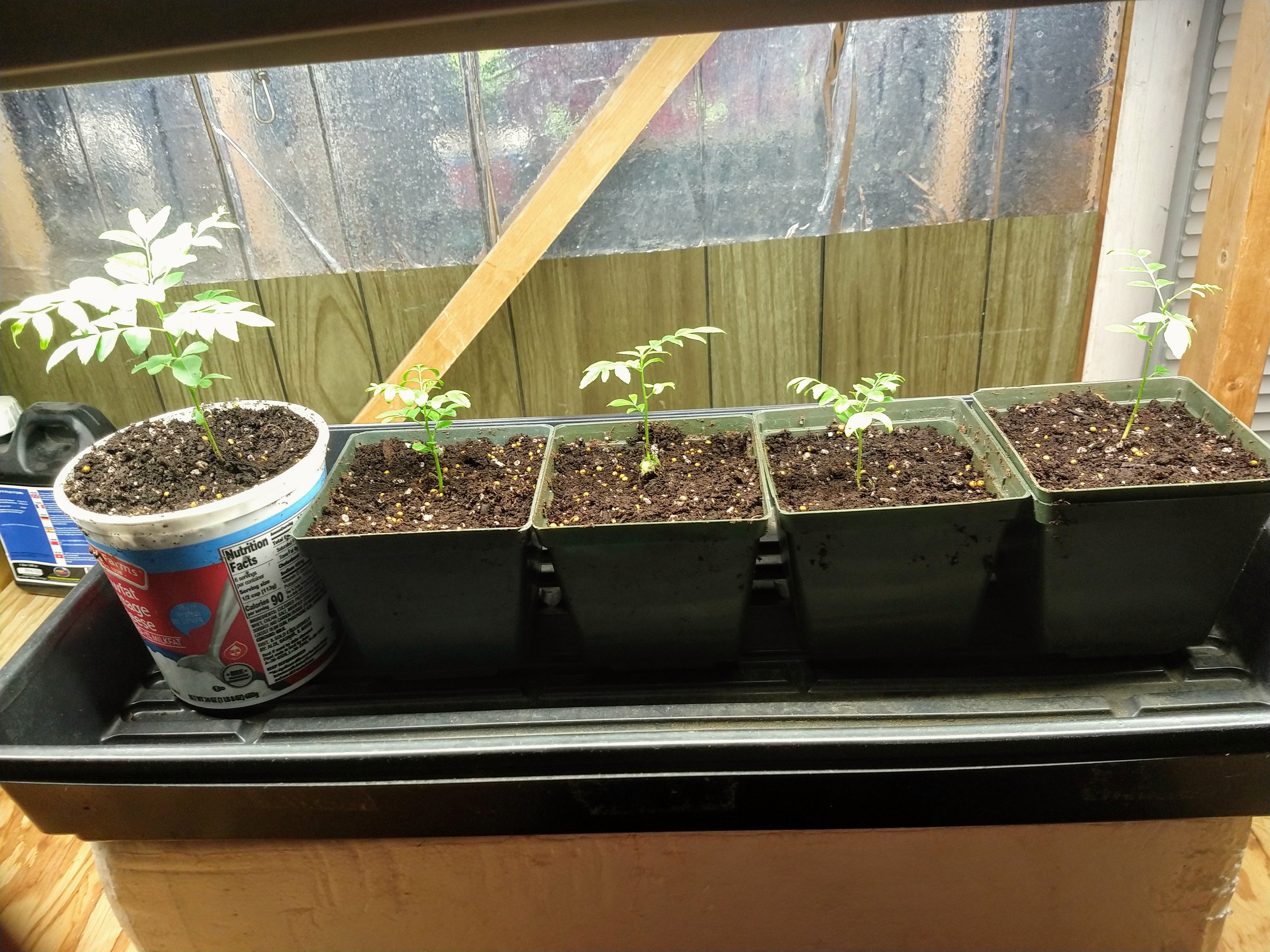 All 5 of the curry tree plants, started from seed, re-potted 1-11-21 by pepperhead212, on Flickr
All 5 of the curry tree plants, started from seed, re-potted 1-11-21 by pepperhead212, on Flickr
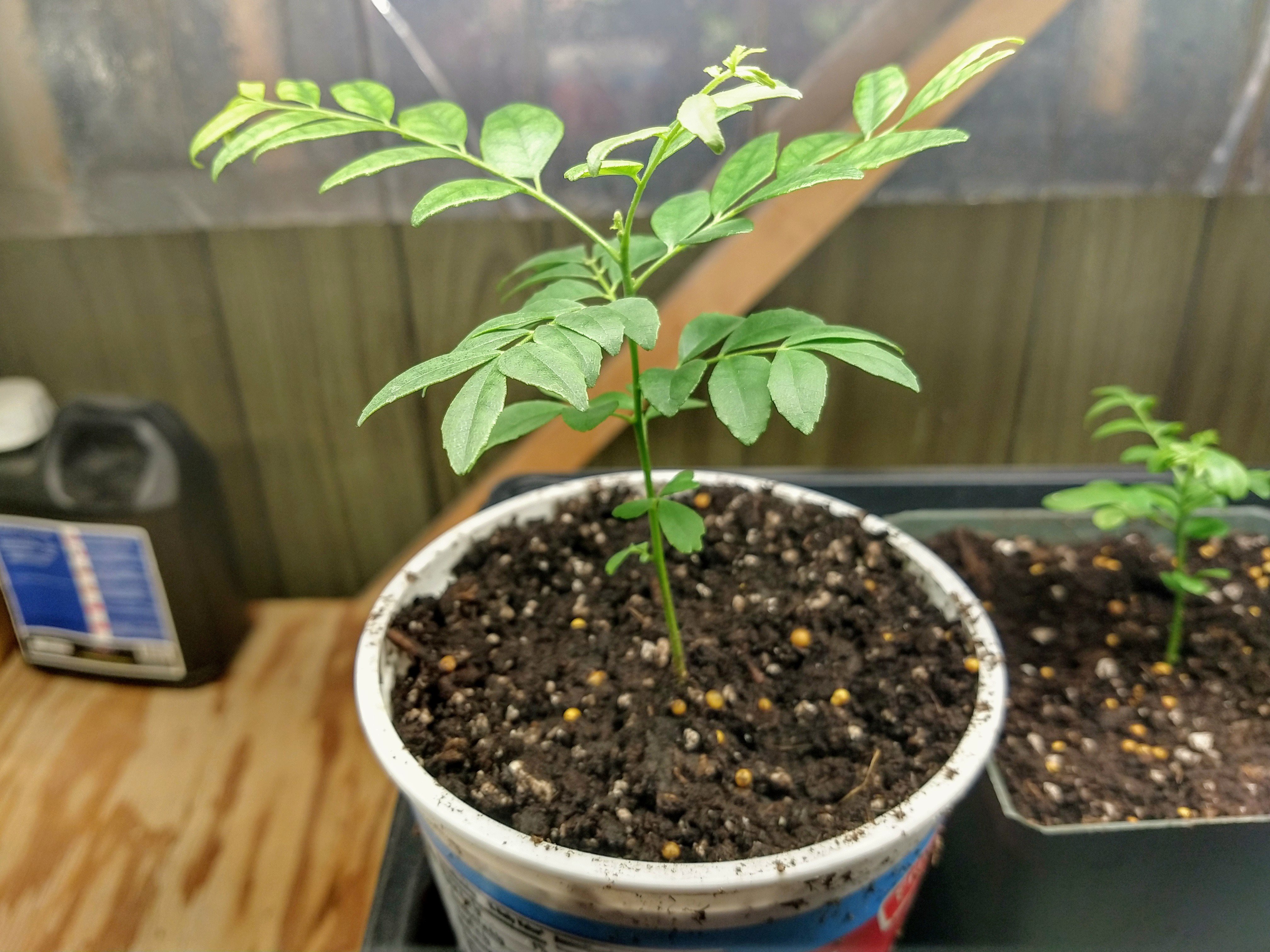 Largest of 5 curry tree plants, started from seed. 1-11-21 by pepperhead212, on Flickr
Largest of 5 curry tree plants, started from seed. 1-11-21 by pepperhead212, on Flickr
 Seeds of the curry tree, from the spring, just now starting to ripen. 9-15 by pepperhead212, on Flickr
Seeds of the curry tree, from the spring, just now starting to ripen. 9-15 by pepperhead212, on FlickrThe seeds are actually the fruits of the plant, with a single seed inside, starting to root, by the time they get dark, and soft:
 Seed, squeezed out of a curry tree fruit, showing the root already started! 9-29 by pepperhead212, on Flickr
Seed, squeezed out of a curry tree fruit, showing the root already started! 9-29 by pepperhead212, on FlickrThis one is eventually the largest of the 5 seedlings:
 Curry tree seedling, growing from a seed. 10-15 by pepperhead212, on Flickr
Curry tree seedling, growing from a seed. 10-15 by pepperhead212, on FlickrHere are those curry tree seedlings more than 3 months after planting! I had a couple more than the original 3 germinate, and two of these were actually came up late, in the pots with 2 of the others, and I left them, since they were an inch or so apart. I had them under a blue LED light, and they seemed to grow well, though slowly (probably the norm), not getting leggy. I re-potted them today, wetting the mix with some dilute hydroponics nutrients, also adding a few drops of Bt israelensis, for the fungus gnats. I transferred them to sit under a stronger LED 5,000k bulb - I'll see if they grow faster.
 All 5 of the curry tree plants, started from seed, re-potted 1-11-21 by pepperhead212, on Flickr
All 5 of the curry tree plants, started from seed, re-potted 1-11-21 by pepperhead212, on Flickr Largest of 5 curry tree plants, started from seed. 1-11-21 by pepperhead212, on Flickr
Largest of 5 curry tree plants, started from seed. 1-11-21 by pepperhead212, on Flickr-
pepperhead212
- Super Green Thumb
- Posts: 2887
- Joined: Wed Oct 15, 2014 1:52 pm
- Location: Woodbury NJ Zone 7a/7b
Those seedlings just never made it - I don't know what happened, but the roots just never strengthened. Maybe next time.
This curry tree I re-potted around 4-1, and put out in mid to late May (May was very cool this year), trimming off a lot of branches. It has really taken off now!
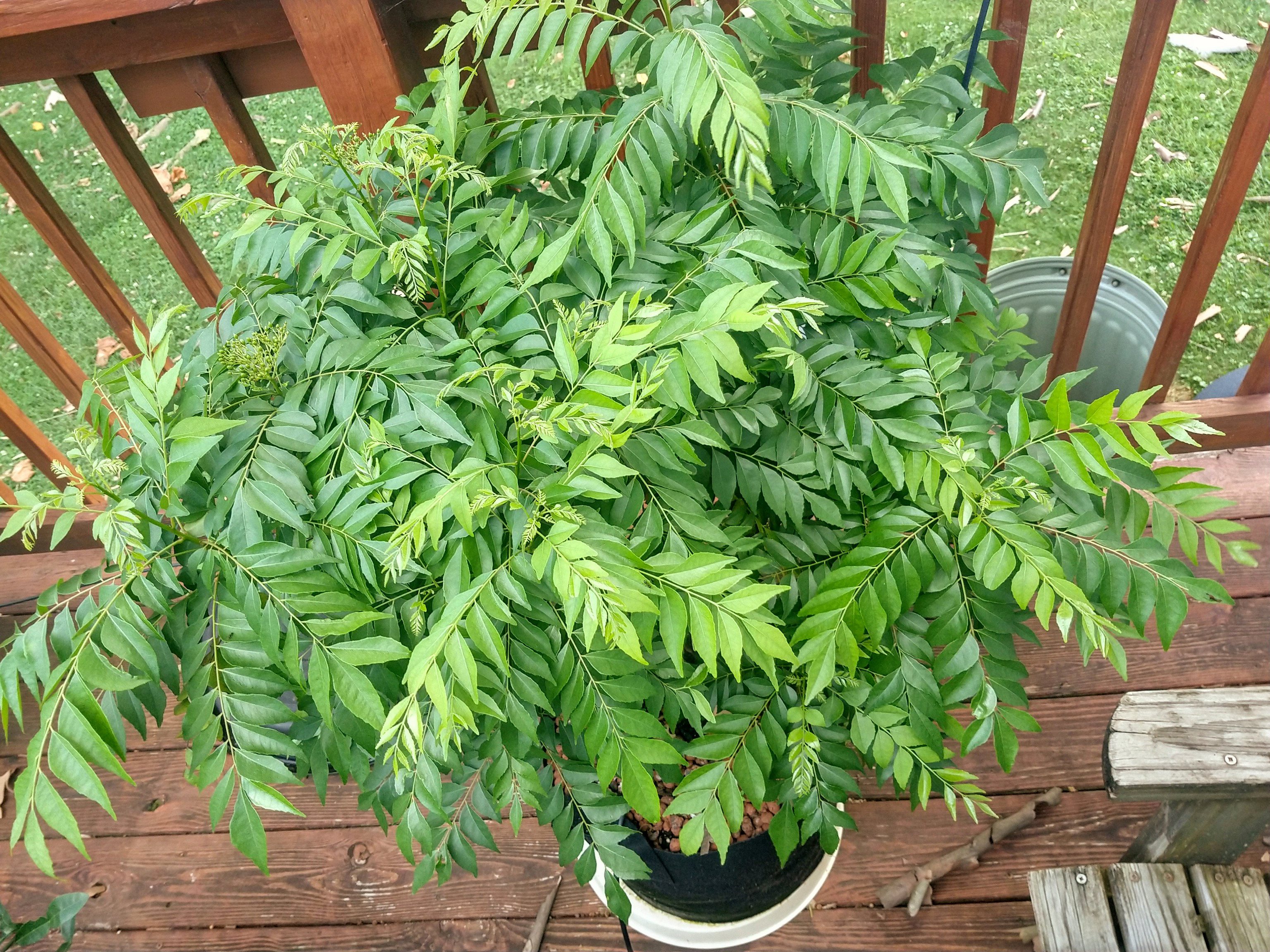 Curry tree, really taking off! 7-14 by pepperhead212, on Flickr
Curry tree, really taking off! 7-14 by pepperhead212, on Flickr
This curry tree I re-potted around 4-1, and put out in mid to late May (May was very cool this year), trimming off a lot of branches. It has really taken off now!
 Curry tree, really taking off! 7-14 by pepperhead212, on Flickr
Curry tree, really taking off! 7-14 by pepperhead212, on Flickr-
pepperhead212
- Super Green Thumb
- Posts: 2887
- Joined: Wed Oct 15, 2014 1:52 pm
- Location: Woodbury NJ Zone 7a/7b
That curry tree got larger than ever this year, probably due to the hot and wet summer I had! Here it is about 3 weeks ago. I have to trim it way back soon, so I can bring it indoors.
 Curry tree, 9-24-21 Incredible growth this year! by pepperhead212, on Flickr
Curry tree, 9-24-21 Incredible growth this year! by pepperhead212, on Flickr
This time I'm trying again, with the seeds, and I had a lot more ripe berries this year. I even sprouted 2 of them in just 2 days in that Instant Pot, and they came up today, but so did one of the 6 that I planted without sprouting them early! Took just over 2 weeks to come up - about what was normal when not started early. Here's a photo - I have it under my new LED, but since it is dimmable, I turned it down, but put it up close. Here are the 3 seedlings, so far, though not easy to see:
 Curry tree seedlings, finally, on 10-16, planted on 09-29 by pepperhead212, on Flickr
Curry tree seedlings, finally, on 10-16, planted on 09-29 by pepperhead212, on Flickr
 Curry tree, 9-24-21 Incredible growth this year! by pepperhead212, on Flickr
Curry tree, 9-24-21 Incredible growth this year! by pepperhead212, on FlickrThis time I'm trying again, with the seeds, and I had a lot more ripe berries this year. I even sprouted 2 of them in just 2 days in that Instant Pot, and they came up today, but so did one of the 6 that I planted without sprouting them early! Took just over 2 weeks to come up - about what was normal when not started early. Here's a photo - I have it under my new LED, but since it is dimmable, I turned it down, but put it up close. Here are the 3 seedlings, so far, though not easy to see:
 Curry tree seedlings, finally, on 10-16, planted on 09-29 by pepperhead212, on Flickr
Curry tree seedlings, finally, on 10-16, planted on 09-29 by pepperhead212, on FlickrGreat. They are easy to sprout. My problem is to cut off the flowers before they make seed, because they will reseed on their own and I don't want them all over the yard. The berries are edible.
I cut mine back about a month ago. I have to cut it back a few times a year just to keep the growth in check. The one at the garden got about 12 ft high. It tolerates being cut back to the ground just fine.
I cut mine back about a month ago. I have to cut it back a few times a year just to keep the growth in check. The one at the garden got about 12 ft high. It tolerates being cut back to the ground just fine.
- Gary350
- Super Green Thumb
- Posts: 7428
- Joined: Mon Mar 23, 2009 1:59 pm
- Location: TN. 50 years of gardening experience.
What is the difference in a Curry tree & Curry spice? Are you using curry tree for spice? I see curry spice in the grocery stores are always a mixture is 5 to 7 different spices. I bought curry spice at the Thai market once is was 9 spices and so spice hot with cayenne pepper we could not eat it. I have not learned how to cook with curry spice yet.
-
pepperhead212
- Super Green Thumb
- Posts: 2887
- Joined: Wed Oct 15, 2014 1:52 pm
- Location: Woodbury NJ Zone 7a/7b
Gary350pepperhead212 wrote: ↑Thu Sep 03, 2020 5:19 pm@Gary, That curry tree is unrelated (sort of) to that spice blend we know as curry powder. In fact, that word curry is an abomination of an Indian word kari, or kadhi, which is how they refer to spiced dishes, which use many different spice mixes, depending on the region. But the curry powder was supposely developed by the British, back in the centuries when they colonized India, and when they went "back home", they wanted something that could give them something similar to what they had been eating in India, because they liked it so much, but they couldn't duplicate it! The curry powders gave them a way of delivering a similar flavor, without having the 10 or 15 spices on hand. Curry leaves are used in many of those types of dishes in India, as well as SE Asia (I originally started growing it for Malaysian cooking), which is how the name developed, but it is not something found in curry powder. It is not really that good dried. Only in recent years have I seen it on a regular basis in the Indian markets, and it still doesn't look real good. One of the few herbs used in Indian cooking - holy basil, or tulsi, is another.
Here is a previous post, where I went into detail on the relationship of the curry tree and powder. There are many types of curry powders out there, some based on what they use in other countries, when trying to get that Indian flavor, but they might have some ingredients used more in their areas (like the cayenne in that Thai curry powder!). You might get some brand of curry powder that you don't like - it's not necessarily what you are doing, but what is in it! I remember some brands I got many years ago that I didn't like - not something from another country, just some brand, and I just didn't like the spice mix. And a few are double priced, stating they have saffron, but you won't taste it, and almost all of them have turmeric, so they make things yellow.
The curry tree is Indian curry leaves. It tastes different from curry spice. Curry spice was created and has various recipes. Mostly turmeric for color and cumin for the flavor and other things. Western curry spice came about when British soldiers returned to England and missed the Indian curries. The ingredients for Indian curry won't all grow in a temperate climate, so curry spice is a blend of spices that were pleasing to their palate and approximated the curry they had in India.
Curry leaves are usually combined with other spices as well including turmeric, coriander, peppers, ginger, garlic, and garam marsala which is a chef's personal spice blend so it can have different ingredients.
Curry leaves are usually combined with other spices as well including turmeric, coriander, peppers, ginger, garlic, and garam marsala which is a chef's personal spice blend so it can have different ingredients.
-
pepperhead212
- Super Green Thumb
- Posts: 2887
- Joined: Wed Oct 15, 2014 1:52 pm
- Location: Woodbury NJ Zone 7a/7b
In late October - when I trimmed the curry tree to bring inside - I tried rooting some cuttings, but like is done with many hardwoods, with no leaves. I had a few hints of growth on two of them, but I finally gave up on trying to root those cuttings - even those ones with minute growths never developed any more leaves, and nothing had any roots on them. Maybe I'll try again, if there's a market for them!
 Ten curry tree cuttings, and two kaffir lime tree cuttings, put in the soil mix on 10-20, attempting to root. by pepperhead212, on Flickr
Ten curry tree cuttings, and two kaffir lime tree cuttings, put in the soil mix on 10-20, attempting to root. by pepperhead212, on Flickr
Amazingly, all but one of the seeds from 9-29 nsprouted, the last 2 much later than the rest. So I got 7 of 8, but two were much smaller, and very few roots, so those I threw out. Those two that I sprouted before putting them in the soil were 2 of the largest, but one of the soil planted ones got the largest mass of roots of any. I transplanted 5 of them - I added a bit of worm castings to the mix, and wetted it down with some hydroponics mix, plus some Bt israelensis, to prevent fungus gnats. I'll see if they grow faster now.
 Curry tree seedlings, started from seed. Ready to be transplanted. by pepperhead212, on Flickr
Curry tree seedlings, started from seed. Ready to be transplanted. by pepperhead212, on Flickr
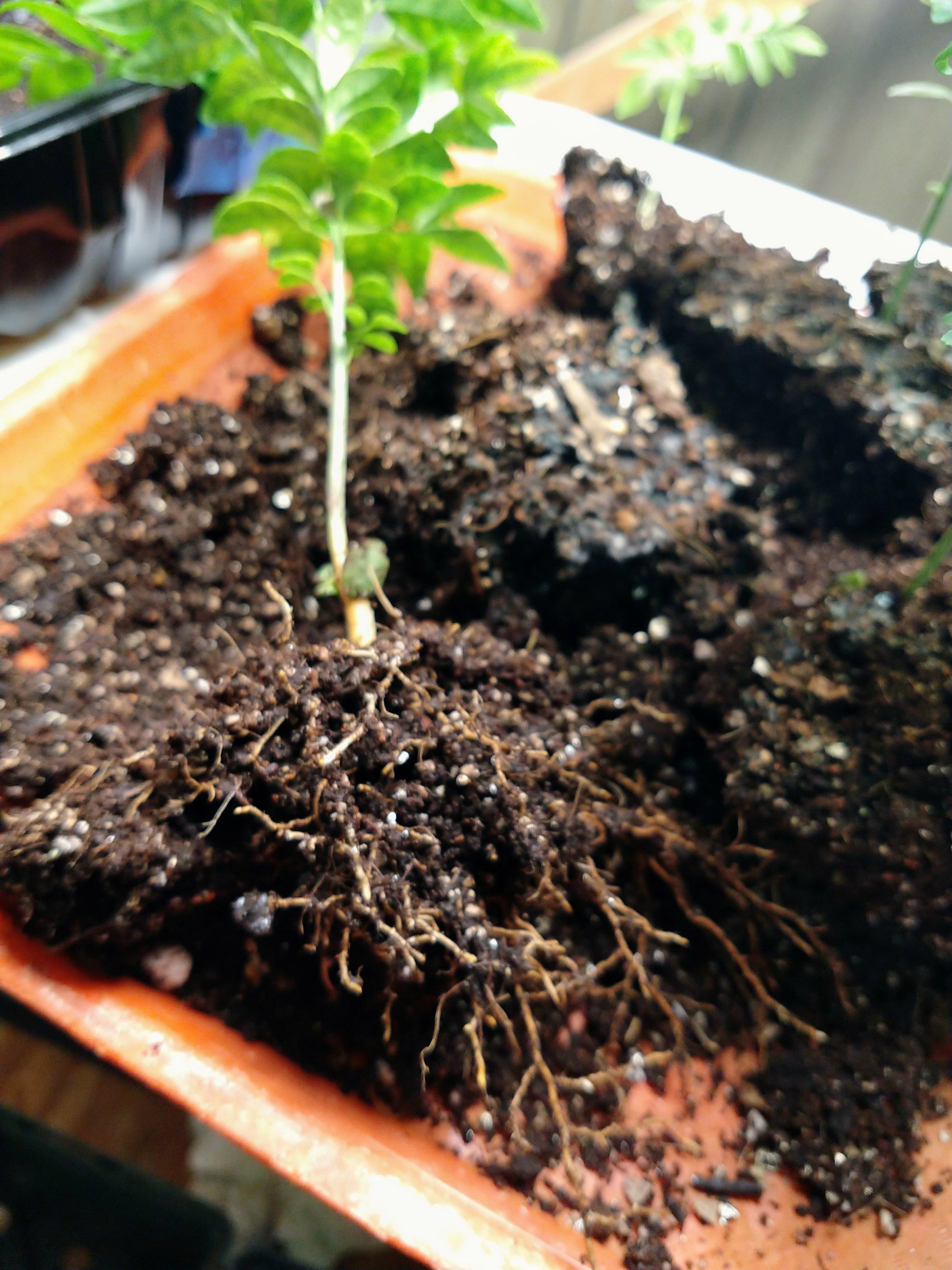 One of the larger curry tree seedlings, showing the roots on it, before transplanting. by pepperhead212, on Flickr
One of the larger curry tree seedlings, showing the roots on it, before transplanting. by pepperhead212, on Flickr
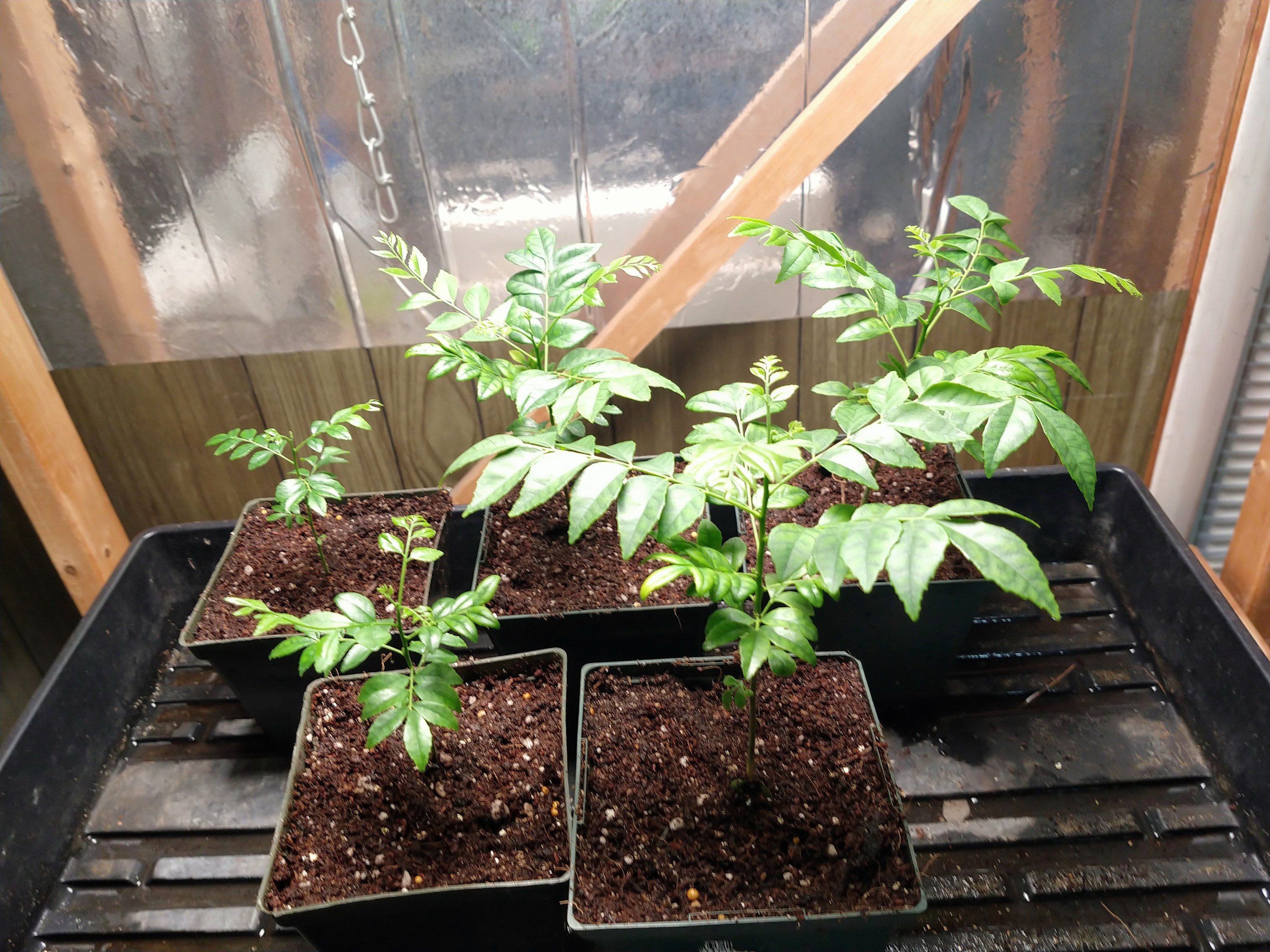 Curry tree seedlings, transplanted, 1-14-22 by pepperhead212, on Flickr
Curry tree seedlings, transplanted, 1-14-22 by pepperhead212, on Flickr
 Ten curry tree cuttings, and two kaffir lime tree cuttings, put in the soil mix on 10-20, attempting to root. by pepperhead212, on Flickr
Ten curry tree cuttings, and two kaffir lime tree cuttings, put in the soil mix on 10-20, attempting to root. by pepperhead212, on FlickrAmazingly, all but one of the seeds from 9-29 nsprouted, the last 2 much later than the rest. So I got 7 of 8, but two were much smaller, and very few roots, so those I threw out. Those two that I sprouted before putting them in the soil were 2 of the largest, but one of the soil planted ones got the largest mass of roots of any. I transplanted 5 of them - I added a bit of worm castings to the mix, and wetted it down with some hydroponics mix, plus some Bt israelensis, to prevent fungus gnats. I'll see if they grow faster now.
 Curry tree seedlings, started from seed. Ready to be transplanted. by pepperhead212, on Flickr
Curry tree seedlings, started from seed. Ready to be transplanted. by pepperhead212, on Flickr One of the larger curry tree seedlings, showing the roots on it, before transplanting. by pepperhead212, on Flickr
One of the larger curry tree seedlings, showing the roots on it, before transplanting. by pepperhead212, on Flickr Curry tree seedlings, transplanted, 1-14-22 by pepperhead212, on Flickr
Curry tree seedlings, transplanted, 1-14-22 by pepperhead212, on Flickr-
pepperhead212
- Super Green Thumb
- Posts: 2887
- Joined: Wed Oct 15, 2014 1:52 pm
- Location: Woodbury NJ Zone 7a/7b
I read about the propogation on some YouTube videos, from India, and it appeared fairly fast. And one guy was dunking the cuttings in turmeric powder, as a rooting powder! I tried 2 of the 8 in that, and 3 in each of a gel and powder hormone. One of the turmeric treated ones was one of the two that had minute growths, but still, nothing happened.
My guess is that those in my house weren't warm enough to root, while those videos in India were probably at least 15° warmer. Probably why the seedlings were so slow, too.
My guess is that those in my house weren't warm enough to root, while those videos in India were probably at least 15° warmer. Probably why the seedlings were so slow, too.
-
pepperhead212
- Super Green Thumb
- Posts: 2887
- Joined: Wed Oct 15, 2014 1:52 pm
- Location: Woodbury NJ Zone 7a/7b
Those rootings did nothing for me again, including some I tried in water, with a little hormex added. If I really want another one, I'll have to go back to air layering, which is all that worked.
I got quite a bit done today, including trimming my curry tree way back, and cleaning up the fabric pot, to bring it inside to my back porch. Didn't really need re-potting. Since the curry tree is less cold tolerant than any of the others, I wanted to get that inside, before starting anything else. Eventually, I might trim a little more - from the tallest, if new growth appears below. I didn't pick the seeds this year; in fact, I didn't even see these or I would have pulled them early.
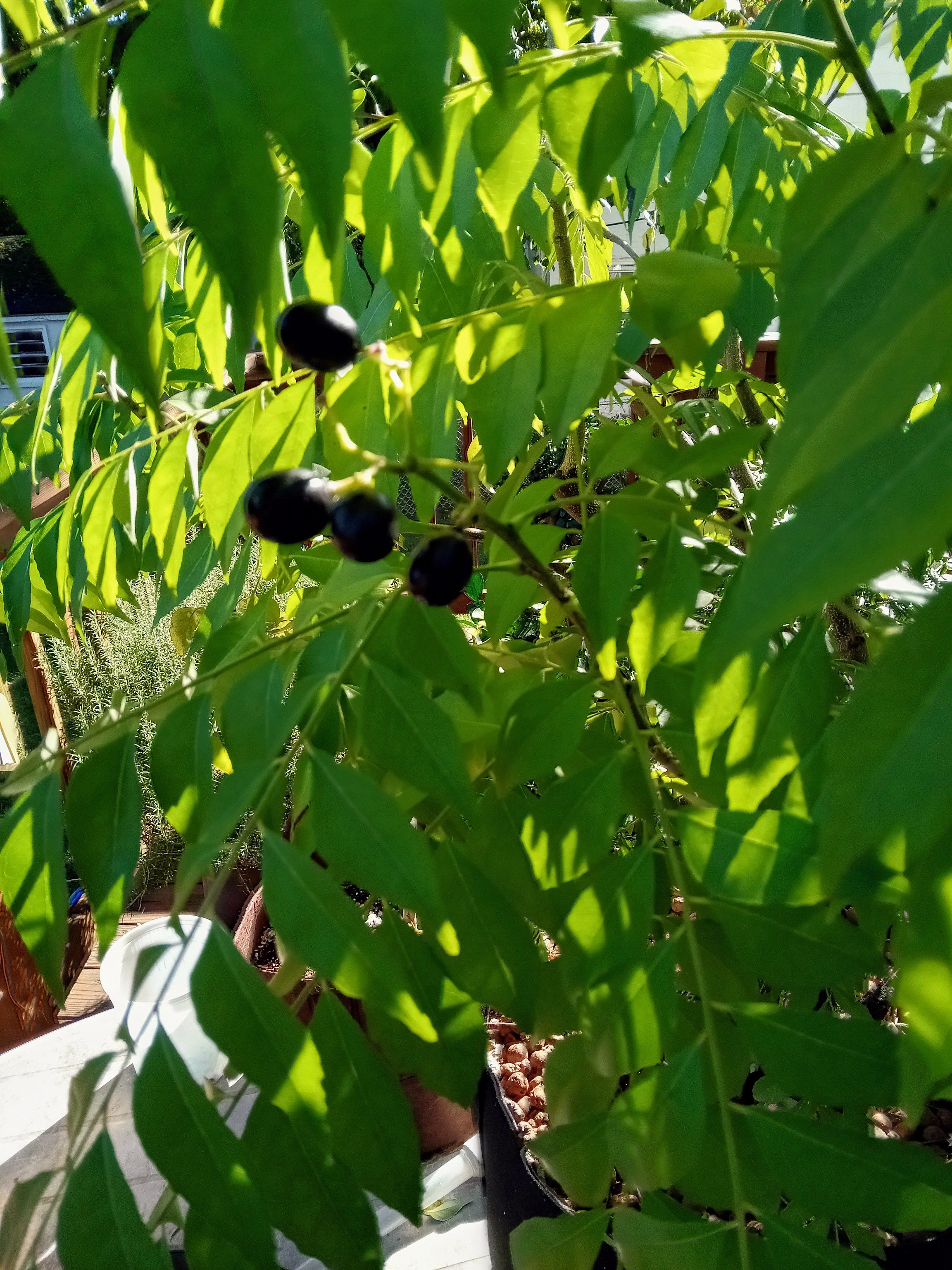 Seeds (actually, the fruits, with one seed each) of the curry tree, 10-8 by pepperhead212, on Flickr
Seeds (actually, the fruits, with one seed each) of the curry tree, 10-8 by pepperhead212, on Flickr
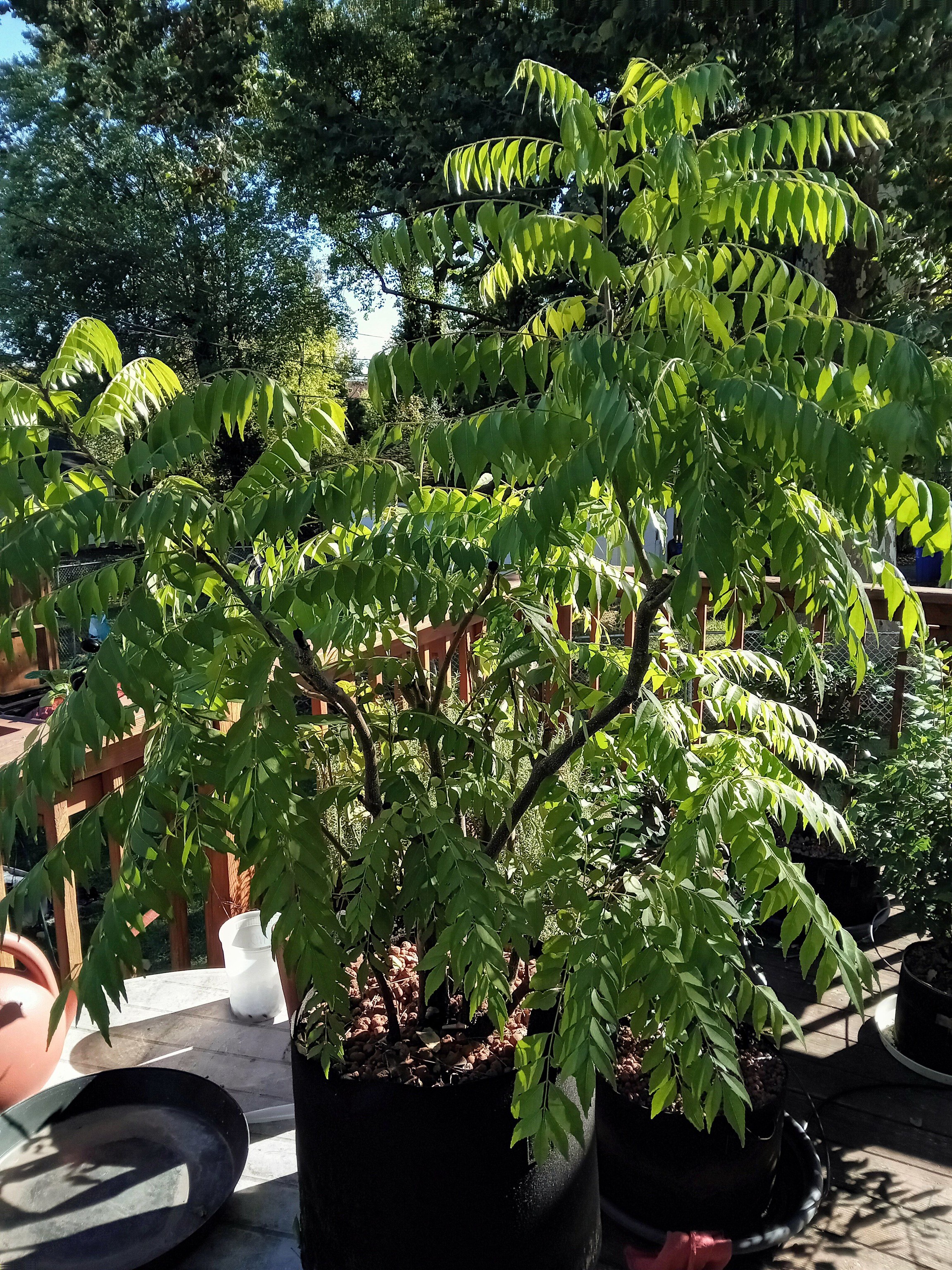 Curry tree, before trimming, to bring inside. by pepperhead212, on Flickr
Curry tree, before trimming, to bring inside. by pepperhead212, on Flickr
 Trimmed branches from the curry tree, 10-8 by pepperhead212, on Flickr
Trimmed branches from the curry tree, 10-8 by pepperhead212, on Flickr
 Finished trimming the curry tree... maybe. by pepperhead212, on Flickr
Finished trimming the curry tree... maybe. by pepperhead212, on Flickr
I got quite a bit done today, including trimming my curry tree way back, and cleaning up the fabric pot, to bring it inside to my back porch. Didn't really need re-potting. Since the curry tree is less cold tolerant than any of the others, I wanted to get that inside, before starting anything else. Eventually, I might trim a little more - from the tallest, if new growth appears below. I didn't pick the seeds this year; in fact, I didn't even see these or I would have pulled them early.
 Seeds (actually, the fruits, with one seed each) of the curry tree, 10-8 by pepperhead212, on Flickr
Seeds (actually, the fruits, with one seed each) of the curry tree, 10-8 by pepperhead212, on Flickr Curry tree, before trimming, to bring inside. by pepperhead212, on Flickr
Curry tree, before trimming, to bring inside. by pepperhead212, on Flickr Trimmed branches from the curry tree, 10-8 by pepperhead212, on Flickr
Trimmed branches from the curry tree, 10-8 by pepperhead212, on Flickr Finished trimming the curry tree... maybe. by pepperhead212, on Flickr
Finished trimming the curry tree... maybe. by pepperhead212, on Flickr-
pepperhead212
- Super Green Thumb
- Posts: 2887
- Joined: Wed Oct 15, 2014 1:52 pm
- Location: Woodbury NJ Zone 7a/7b
I use that in many different things, with various spices, but something I use it in a lot, in many types of Indian dishes, is Tarka. It is "tempering" spices, added at the end, and it varies, but often has the curry leaves added at the end. It only takes about 2 minutes to make, by heating up a small amount of oil in a small pan - they have a small pan specifically for this, and I have a 1 qt saucepan that I use mainly for this - a small amount of mustard seeds are added, and cooked until the crackle, or sputter, then cumin seeds are added (sometimes urad dal here) and some dry peppers, if used, and when the peppers darken, the curry leaves and a little asafoetida is added here. The curry leaves crackle violently here, and when they subside, it is poured into the curry, or whatever it is added to, and it's done. About 30 sec actually cooking, if that. I often add this even to dishes that don't call for it, and sometimes it is made even simpler, but the curry leaves are almost always in it!
There are a lot of powdered spice mixes, or masalas, that have a generous amount of curry leaves added. Sambar masala and Rasam masala are two I make the most, but some have even more than those.
There are a lot of powdered spice mixes, or masalas, that have a generous amount of curry leaves added. Sambar masala and Rasam masala are two I make the most, but some have even more than those.
Sounds great. So far, I have only used it in one recipe for potatoes, it is similar pan frying herbs in oil: cumin seeds, chilies, turmeric, and curry leaves. Adding cubed potatoes, saute for a few minutes, then add water and cook stirring occasionally until the potatoes are done. Served with puris or rotis. I served it with rice.
Its good to have other ways to use it.
Its good to have other ways to use it.
- Gary350
- Super Green Thumb
- Posts: 7428
- Joined: Mon Mar 23, 2009 1:59 pm
- Location: TN. 50 years of gardening experience.
Winter 2 years ago I did a lot of online research for curry spice. Online says, there are many different types of curry spice, northern China curry spice is different than southern China, Vietnam is different, Thailand is different, India is different. Curry spice is a mix of several spices usually 6 to 15 different spices. For a while I watched, Taste of India, YouTube cooking videos to learn how to cook India food. A friend gave me a India cook book. The hardest thing for me is to find the correct spices. India cook book talks about the importance of fresh spices and spices are cooked in OIL not water this traps the flavor & aroma into the oil that is then added to food at the very end of the cook. I went to the market with a Vietnam lady friend she helped me buy 2 different curry spices, 1 was so fire hot I could not eat it, the other 1 was not very good. I like Tikka Masala spice but I can not make it as good at the local restaurant. Tikka Masala sauce in a jar from the grocery store use to be good but they changed it by adding 50% more tomatoes and doubled the price, its not as good anymore. I can't afford to eat at the India restaurant anymore price is $50 for the 2 of us to eat lunch. Book & videos say, cooking technique and fresh spices are very important. You need to experiment with different recipes to find 1 you like.
Murraya koenigii is an Indian curry tree. It does not taste anything like curry powder in store. Curry powder does not have any Murraya in it. Thai curry has other spices, cilantro roots, chilies, kaffir lime leaves,galangal, garlic, lemon grass, salt, turmeric, and shrimp paste.
There are as many curry spices as there are garam masala. Curry powder or paste recipes can have anywhere from 8-20 ingredients.
Cooks will often customize the curry blend to their liking.
There are as many curry spices as there are garam masala. Curry powder or paste recipes can have anywhere from 8-20 ingredients.
Cooks will often customize the curry blend to their liking.
-
pepperhead212
- Super Green Thumb
- Posts: 2887
- Joined: Wed Oct 15, 2014 1:52 pm
- Location: Woodbury NJ Zone 7a/7b
Well, it only took 2 years and that tree got rootbound again. Even after trimming the stalks, which usually makes several more go out from each branch, just didn't do anything. In previous years, it would have grown considerably, once it was put outside, so I knew I had to re-pot it. I'll post a photo of what it does, when it finally takes off.
I had to pound the fabric pot, to loosen the roots, then I sliced much of it off. I loosened much of the soil from the roots, and sifted it, and used about half that, and half that peat/coir/worm castings/perlite mix, with the micorrhyzae, plus I put some Biotone in as organic fertilizer. We'll see how fast this kicks in.
 Rootball of the curry tree, definitely rootbound, and showing signs of it, which made me re-pot it. by pepperhead212, on Flickr
Rootball of the curry tree, definitely rootbound, and showing signs of it, which made me re-pot it. by pepperhead212, on Flickr
 Here is the curry tree, with at least 2/3 of the ball trimmed off, to re-pot. by pepperhead212, on Flickr
Here is the curry tree, with at least 2/3 of the ball trimmed off, to re-pot. by pepperhead212, on Flickr
I had to pound the fabric pot, to loosen the roots, then I sliced much of it off. I loosened much of the soil from the roots, and sifted it, and used about half that, and half that peat/coir/worm castings/perlite mix, with the micorrhyzae, plus I put some Biotone in as organic fertilizer. We'll see how fast this kicks in.
 Rootball of the curry tree, definitely rootbound, and showing signs of it, which made me re-pot it. by pepperhead212, on Flickr
Rootball of the curry tree, definitely rootbound, and showing signs of it, which made me re-pot it. by pepperhead212, on Flickr Here is the curry tree, with at least 2/3 of the ball trimmed off, to re-pot. by pepperhead212, on Flickr
Here is the curry tree, with at least 2/3 of the ball trimmed off, to re-pot. by pepperhead212, on FlickrMy curry tree broke through the pot years ago. It is in the ground and it needs to be cut back two to three times a year. I think when you get seeds, you should pot up seedlings, to replace the older plant rather than try to repot. Or try air layering. A lot of the tropical plants will grow better from layers, than cuttings.
-
pepperhead212
- Super Green Thumb
- Posts: 2887
- Joined: Wed Oct 15, 2014 1:52 pm
- Location: Woodbury NJ Zone 7a/7b
